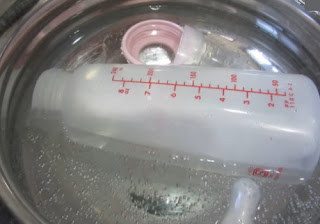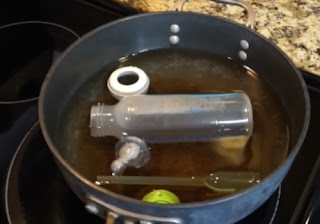How to Sterilize Plastic Baby Bottles and Nipples

Are you looking for how to sterilize plastic baby bottles and nipples? When we touch our newborn, the first feeling is the most auspicious that we ever experience in our life. All the agony, pain, anxiety of pregnancy, vanished in a while; simultaneously, parenthood’s responsibilities begin, making you conscious about the child’s health and cleanliness. Every mom tries to give their best effort to keep their baby safe and healthy.
As we all know, babies are prone to infection as their immunity takes some time to develop; until then, it’s essential to sterilize your entire baby’s feeding equipment and other necessary things. Though new moms are unaware of sterilization, we are here to give you detailed information about the safest way to keep your baby healthy and free from infection. So stay with us.
In This Article
- What is Sterilization
- How Often should you Sterilize Baby Bottles
- Do I need to Sterilize Bottles Every Time
- How to Sterilize Plastic Baby Bottles and Nipples
- Safe Way to Sterilize Baby Bottles
What is Sterilization
The word sterilization means to make anything free from bacteria or other contagious microorganisms.
Sterilization is being performed by a number of methods such as heat, chemicals, irradiation, high pressure, and filtration.
How Often should you Sterilize Baby Bottles
Generally, breast milk is the perfect food for a newborn baby, but babies may need infant formula in rare exceptional cases. However, feeding a newborn is a round-the-clock engagement for a mom, and it is an excellent way to bond with the infant.
Some new moms can’t breastfeed in some cases, and some don’t want to; infant formula is the only option to feed their babies. As you depend on infant formula, there are requirements for feeding equipment like feeding bottles, rings, cap teats, etc.
We usually buy these apparatus from the medical shop. Usually, we do not bother to wash or sterilize new bottle or feeding sterilize as it is unused. But this is entirely a misconception that can cause harm to your baby.
The brand new feeding equipment is not free of germs and microorganisms because before you get them, they travel a long way, starting from manufacturing to packaging. So it’s beyond your imagination how and where the bottle has been handled and packaged and transported.
Besides this, there are lots of chemicals that have been used as raw materials. And before you get them in a beautiful package, it has been possibly touched by many germ-ridden hands. So you must know a few facts about when to sterilize baby bottles.
- Sterilize is a must when you buy a brand new fresh bottle.
- After every use, baby feeding equipment should undergo a sterilizing process.
- Sterilizing works as a safeguard and also to ensure safety from many infectious diseases, especially stomach disorders.
- Sterilizing is also a must in the feeding bottle handed down from the family’s elder sibling to the new one.
- Suppose the infant has been born with various health issues and undergoing any medical treatment. In that case, regular sterilization is a must to protect them or help them recover from health problems.
- If your locality does not get pure drinking water and depends on the unreliable water source, then the only way to stop stomach infection is sterilizing after every use.
Do I need to Sterilize Bottles Every Time
Sterilization is the best process to follow to make anything germ-free, especially surgical instruments or feeding equipment for newborns. Although the methods are entirely separate, the motive is the same. Usually, some unique reasons work behind this. Therefore a detailed discussion about the cause is a must.
- In general, a child is born with an underdeveloped immune system, so they are vulnerable to infection caused by microorganisms compared to older children. All these pathogens are harmful to infant health and can lead to stomach infection.
- Sterilization is a must when different feeding equipment is used for feedings, such as feeding bottles, nipples, or other accessories. Although you are using a new set, do not forget to clean and sterilize it before use.
- Usually, we clean feeding bottles after using them, but germ can grow rapidly in used and damp bottles. So going through sterilization is the safest way.
- Sterilization is an added safest way to kill the whole germ, including viruses and bacteria.
- A child carries only those disease-fighting antibodies that they inherit from their mother’s gene during the last three months of pregnancy. But this acquired passive immunity disappears soon within few months of birth.
How to Sterilize Plastic Baby Bottles and Nipples
There are different popular methods to sterilize baby bottles which include-
1. In Boiling water
Sterilizing feeding accessories in boiling water is a common process. In this process, the feeding bottle and other used things like spoons, nipples etc., dipped into normal water and boiled until half an hour.

Methods
- Before boiling anything, make sure that it is safe at a high temperature.
- Take a big bot or dip pan-type utensil where you can quickly dip the equipment.
- Pour normal water into the pan.
- Clean the feeding bottle so that it is free from any food residue.
- Put the pan in the oven on high flame.
- Let the water starts boil, cover it with a lid.
- Boil bottle treats, caps, nipples for 15 minutes in high flame.
- Turn the gas off.
- The bottle is ready to reuse.
2. Sterilizing by Chemicals
There is some antibacterial solution that is used to sterilize baby bottles. This chemical is a type of bleach that is water-soluble, and it is strong enough to damage all bacteria that cause infection.
You can buy these specific chemicals from the medical shop and mix them with water properly.
Methods
- Mix the chemicals into a 1:16 ratio with hot water. It means you have to take only one tablespoon of bleaching reagent with 16 cups of hot water.
- Mix it well and put all the bottles, nipples, and accessories into the solution for at least 2 to 3 minutes.
- Ensure that your bottles and teats are free of air bubbles before you dip them in the solution.
- Use a long bottle washer brush to clean the bottle and run the solution through the nipples.
- Air-dry the bottles and other things.
Read Also: How to Calm a Fussy Baby at Night
3. With Cold Water
It is impossible to follow boiling or other procedures during travelling. Therefore the best option is to use a sterilization tablet which is manufactured especially for bottle-sterilization.

Method
- Dip the bottle in water in a container.
- Add the sterilization tablet and let it dissolve into it.
- Run the solution through the bottle and shake it well.
4. With Steam Help
Like boiling, steaming is another option to sterilize the feeding apparatus. In this procedure, bottles are sterilized by steams at a high temperature to kill all the bacteria and microorganisms in the bottle.
You can either use a microwave or electrical sterilizer to perform the purpose.
Method
- Keep the bottle inside the sterilizer or in the micro oven in an oven-friendly container in a downwards direction, which means you have to keep the opening of the bottle facing down.
- Add water to the unit and turn it on for1 to 2 minutes. The water will get hot and produce steam.
- Leave the feeding tools inside the container until you need them to use.
See Also: Side Effects of Baby Diapers
5. Using Dishwasher
Modern households are equipped with so many gadgets and tools to minimize workload, and a dishwasher is one of them. Or you can easily sterilize baby bottles with the help of a dishwasher just after the first sterilization.
This method has a limitation as all dishwasher machines are capable of generating high heat needed for sterilization.
Method
- Keep all items that you wish to sterilize in the top rack of the dishwasher.
- Place other small accessories like nipples, pacifiers in the basket.
- Start your machine in sterilized mode.
6. Sterilizing by a UV sterilizer
A helpful procedure to keep your baby safe from infection during travelling or at home. All you need is a UV sterilizer in which ultraviolet rays kill germs like bacteria, viruses, and highly infectious pathogens.
Parents who travelled a lot can use portable UV sterilizers to use while travelling.
Methods
- Keep used bottles in the sterilizer.
- Push the start button to run the machine.
- Wait for the device to auto-stop.
Safe Way to Sterilize Baby Bottles
Sterilizing baby bottles is not at all a tough job; anyone can do it. But there are some safety majors you are going to do. Let us check—
- Before buying any bottle, read all the details about the material and other things.
- Know first whether the bottles are safe to boil or not.
- You must follow the pre sterilization rituals. These rituals include washing hands and making them dry before touching the bottles and other feeding parts.
- Do not leave hot water or boiling water within reach of children. It may cause an accident.
- If you are using a micro oven or other machines for sterilizing, stay aware and mindful.
- Keep all the bleaching chemicals in such a place that is unreachable for children.
- Before you start sterilizing, wash your hand thoroughly.
- Do not touch the sterilized bottle with unwashed hands as your hand may contain germs to contaminate the bottle.
- Use a sterilized tong to remove the bottle and other things.
- To reuse, always assemble the bottles on a clean and dis- infected surface.
- Though there are various opinions about how frequently sterilization should be done, it is recommended to consult any medical expert. The whole thing depends on few factors connected to the specific health problems.
- In general, terms sterilizing procedure should be continued for 4 months and after that only cleaning is sufficient.
Be sure to read: Calamine lotion uses for baby
In Closing
So, friends, baby bottle sterilization is not at all challenging, but it needs your awareness and mindfulness a lot. However, we all know that breast milk is best for babies, but if you have to choose another option for feeding, you must go through the sterilizing methods in detail to ensure good health for your newborn.
Your baby needs your care and protection to live a healthy life. So do not skip any steps regarding the sterilization procedure. We hope that after going through the above how to sterilize plastic baby bottles and nipples will surely help you. So don’t delay to take the benefits of it.





